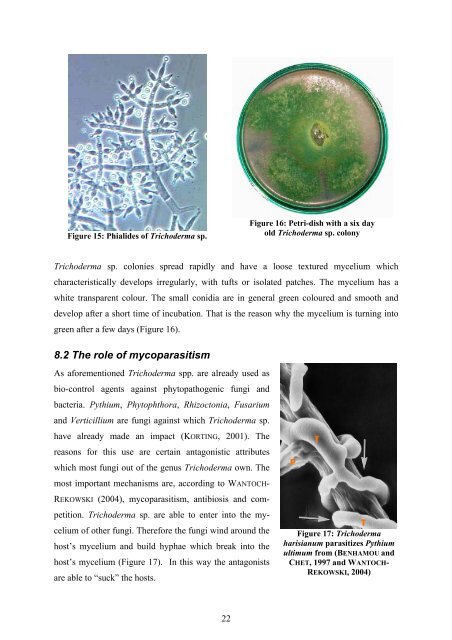Botryodiplodia sp. - Crops for the Future
Botryodiplodia sp. - Crops for the Future
Botryodiplodia sp. - Crops for the Future
Create successful ePaper yourself
Turn your PDF publications into a flip-book with our unique Google optimized e-Paper software.
Figure 15: Phialides of Trichoderma <strong>sp</strong>.<br />
Figure 16: Petri-dish with a six day<br />
old Trichoderma <strong>sp</strong>. colony<br />
Trichoderma <strong>sp</strong>. colonies <strong>sp</strong>read rapidly and have a loose textured mycelium which<br />
characteristically develops irregularly, with tufts or isolated patches. The mycelium has a<br />
white tran<strong>sp</strong>arent colour. The small conidia are in general green coloured and smooth and<br />
develop after a short time of incubation. That is <strong>the</strong> reason why <strong>the</strong> mycelium is turning into<br />
green after a few days (Figure 16).<br />
8.2 The role of mycoparasitism<br />
As a<strong>for</strong>ementioned Trichoderma <strong>sp</strong>p. are already used as<br />
bio-control agents against phytopathogenic fungi and<br />
bacteria. Pythium, Phytophthora, Rhizoctonia, Fusarium<br />
and Verticillium are fungi against which Trichoderma <strong>sp</strong>.<br />
have already made an impact (KORTING, 2001). The<br />
reasons <strong>for</strong> this use are certain antagonistic attributes<br />
which most fungi out of <strong>the</strong> genus Trichoderma own. The<br />
most important mechanisms are, according to WANTOCH-<br />
REKOWSKI (2004), mycoparasitism, antibiosis and competition.<br />
Trichoderma <strong>sp</strong>. are able to enter into <strong>the</strong> mycelium<br />
of o<strong>the</strong>r fungi. There<strong>for</strong>e <strong>the</strong> fungi wind around <strong>the</strong><br />
host’s mycelium and build hyphae which break into <strong>the</strong><br />
host’s mycelium (Figure 17). In this way <strong>the</strong> antagonists<br />
are able to “suck” <strong>the</strong> hosts.<br />
Figure 17: Trichoderma<br />
harisianum parasitizes Pythium<br />
ultimum from (BENHAMOU and<br />
CHET, 1997 and WANTOCH-<br />
REKOWSKI, 2004)<br />
22

















